Navaratri (नवरात्रि) Festivity 2023
Navaratri 2023 Festivity (नवरात्रि) (Navadurga):- Navadurga, which means, in romanization: In Hinduism, there are nine manifestations and forms of Durga known as Navadurg (also spelled Navdurga and Navadurgas). These forms are especially venerated during Navaratri and Durga Puja. Most of the people who follow the Shaktism and Shaivism sects of Hinduism think of them as a single deity.
The nine forms are regarded as Durga’s nine stages in Hindu mythology during the nine-day conflict with the demon-king Mahishasura when the tenth day is celebrated as Vijayadashami (lit. referred to as “victory day” by Hindus, and it is regarded as one of the most significant festivals.
Background
Nine unmarried virgin girls under the age of nine are worshiped and fed during the Navaratri festival because they are believed to be the incarnations of these nine goddesses. Then, during Durga Puja, the Nabapatrika ritual involves tying the leaves of eight plants to the branches of a banana plant (naba means “nine” and patrika means “leaves”).
The nine forms 2023
| S. No. |
Mantra |
Name |
Stage |
Vahana |
Depiction |
Image
(Depiction) |
| 1. | ॐ देवी शैलपुत्र्यै नमः | Shailaputri“Daughter of Mountain” | Parvati in her stage of childhood with the divine and principal form being Durga | Nandi (bull) | She was dressed in red and pink robes and wore light ornaments on her limbs. She is holding a lotus and trident in both of her hands. She is seated on the white bull’s hindquarters. | 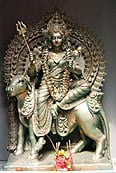 |
| 2. | ॐ देवी ब्रह्मचारिण्यै नम: | Brahmacharini“Mother of devotion and penance” | Durga in her phase of asceticism. | None | She is dressed as a female ascetic and is adorned with flowers and dried Rudraksha beads. She carries a water utensil and rosary in both of her hands. |  |
| 3. | ॐ देवी चंद्रघण्टायै नम: | Chandraghanta“Destroyer of demons” | Durga in the form of Shakti. | Tiger | She has ten hands, nine of which are armed with a trident, a mace, a bow, an arrow, a lotus, a sword, a bell, and a waterpot. The other hand gives blessings to her followers. She is perched atop a menacing tiger. | 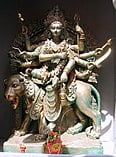 |
| 4. | ॐ ऐं ह्रीं क्लीं कूष्मांडायै नम: | Kushmanda“Goddess of The Cosmic Egg” | Durga in the form of Mahashakti. | Lion | She has eight hands; two of them carry a jar of honey and a waterpot, while the other six hold a discus, mace, lotus, bow, arrow, sword, and rosary. She is mounted upon the rear of a lion. | 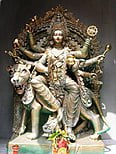 |
| 5. | ॐ देवी स्कन्दमातायै नम: | Skandamata“Goddess of motherhood and children” | Durga is in her stage of motherhood. | Lion | She has four hands, two of which are holding lotuses, the third is holding her son, the six-headed infant Kartikeya seated on her lap, and the fourth is saving her devotees. Two of her hands were holding lotuses. She is seated on a lion’s back. | 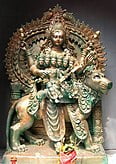 |
| 6. | ॐ देवी कात्यायन्यै नम: | Katyayani“Goddess of Power” | Durga in the warrior stage. | Lion | She wears green and pink vestments and has a lot of ornamentation on her limbs. Each of her four hands held a trident, lotus, sword, and shield. She is seen sitting on a terrifying lion. | 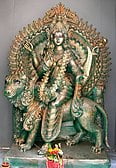 |
| 7. | ॐ देवी कालरात्र्यै नम: | Kalaratri“Goddess of Auspiciousness and Courage” | Durga in her form of destruction. | Donkey | She has unkempt hair, three bloodshot eyes, and a lightning-like garland of skulls around her neck. Her four hands generally held a harpoon, scimitar, vajra, and cup. She is situated behind a jackass in her vehicle. | 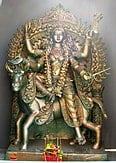 |
| 8. | ॐ देवी महागौर्यै नम: | Mahagauri“Goddess of Beauty and Women” | Durga in her form of recovery. | Ox | She has four hands; three of them carry a trident, a miniature drum, and a pink lotus, and one hand promises protection to her followers. A white ox supports her as she sits. | 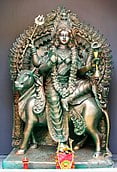 |
| 9. | ॐ ऐं ह्रीं क्लीं सिद्धिदात्यै नम: | Siddhidhatri“Goddess of Supernatural Powers or Siddhis” | Durga is in her stage of reaching her highest and supreme form as Mahashakti. | Lotus | A mace, a discus, a conch shell, and a pink lotus were in each of her four hands. She is sitting on a lotus that is fully blooming. | 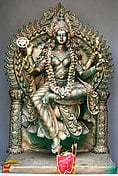 |
Other forms
Navadurga comes in various forms, according to Hindu scriptures and traditions. These are listed in the Agni Purana:
-
-
Rudrachanda
-
Prachanda
-
Chandogra
-
Chandanayika
-
Chanda
-
Chandavati
-
Chandarupa
-
Atichandika
-
Ugrachanda
-
Nine types of Rajarajeshwari are revered as Navadurga structures on the nine days of Navaratri at the well-known Kanaka Durga Sanctuary in Vijayawada, Andhra Pradesh.
-
-
Swarna Kavachalankrita Durga
-
Bala Tripurasundari
-
Annapurna
-
Gayatri
-
Lalitha Tripura sundari
-
Saraswati
-
Mahalakshmi
-
Durga
-
Mahishasuramardhini
-
———————————————————- The End —————————————————–
www.GKDuniya.in will update many more new jobs and study materials and exam updates, keep Visiting and share our post of Gkduniya.in, So more people will get this. This content and notes are not related to www.GKDuniya.in and if you have any objection over this post, content, links, and notes, you can mail us at gkduniyacomplaintbox@gmail.com And you can follow and subscribe to other social platforms. All social site links are in the subscribe tab and bottom of the page.
Important Links
Official Links ———————————————————- Related Links
You-tube ———————————————————- GKDuniya9
Instagram ———————————————————- GKDuniya.in
Facebook ———————————————————- GKDuniya.in
Twitter ———————————————————- GKDuniya.in
Linkedin ———————————————————- GKDuniya.in
Pinterest ———————————————————- GKDuniya.in
Google Rank ———————————————————- Gkduniya


